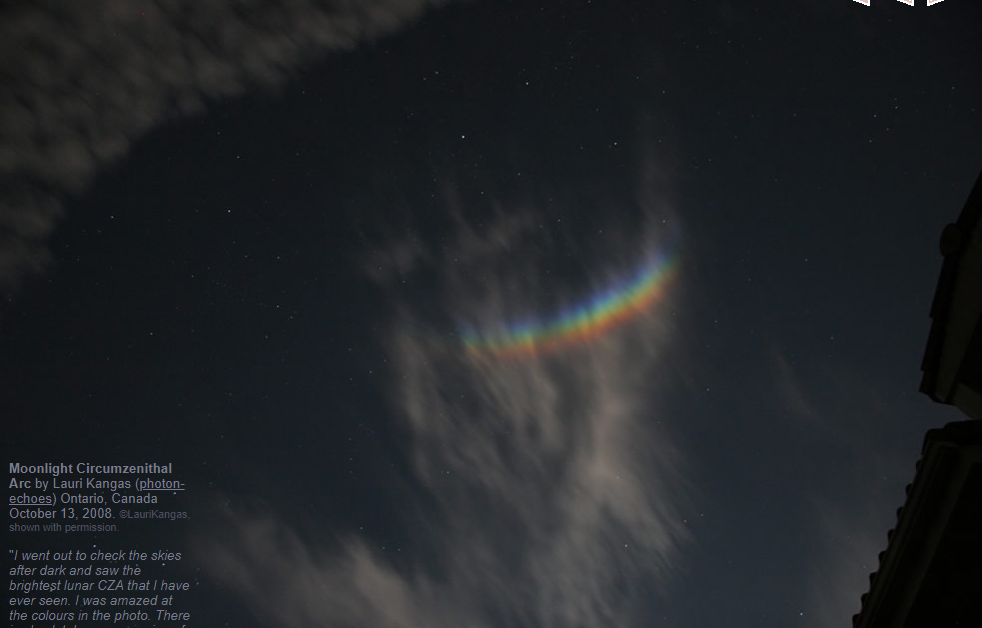Lunar Circumzenithal Arc, Ontario, Canada
Lunar Circumzenithal Arc, Ontario, Canada: A Stunning Atmospheric Phenomenon
Have you ever looked up at the night sky and witnessed a mesmerizing display of colors surrounding the moon? If you have, you may have witnessed a lunar circumzenithal arc (CZA). This captivating atmospheric phenomenon occurs when light interacts with ice crystals in the Earth's atmosphere, creating a stunning spectacle that is sure to leave you in awe. One particularly notable sighting of the lunar CZA took place in Ontario, Canada, on October 13, 2008. Photographer Lauri Kangas captured this breathtaking moment and shared it with the world.
The lunar CZA observed in Ontario, Canada, on that fateful night was an extraordinary sight to behold. Kangas, who was simply checking the skies after dark, stumbled upon the brightest lunar CZA he had ever seen. The colors in the photograph were so vibrant and striking that they required no post-processing whatsoever. It is a testament to the incredible beauty that nature can provide when atmospheric conditions align perfectly.
To fully appreciate the wonder of the lunar CZA, it is essential to understand the science behind it. This atmospheric phenomenon is classified as a type of halo, which is a ring of light that forms around the sun or moon due to the refraction and reflection of light by ice crystals suspended in the atmosphere. Unlike other halos, such as the more commonly observed 22-degree halo, the lunar CZA is a much rarer occurrence. Its unique positioning near the zenith, or directly overhead, adds to its allure.
The formation of a lunar CZA begins with the presence of hexagonal ice crystals high up in the atmosphere. These ice crystals act as tiny prisms, bending and refracting light as it passes through them. When moonlight enters these ice crystals at a specific angle, it undergoes a process called refraction, where it splits into its constituent colors. This dispersion of light creates a vivid display of hues that make up the lunar CZA.
The specific conditions required for a lunar CZA to occur are quite particular. First, the ice crystals must be of a specific shape and orientation to refract the light in just the right way. Second, the moon must be positioned at a particular elevation in the sky to create the necessary angle for the light to enter the ice crystals. Finally, the viewer must be located in a specific position on Earth to observe the lunar CZA near the zenith.
The rarity of the lunar CZA makes each sighting a truly special event. The fact that Kangas captured such a vibrant and clear image of this phenomenon is a testament to both his skill as a photographer and the exceptional atmospheric conditions present on that October night in Ontario, Canada. It serves as a reminder of the beauty and intricacy of our natural world.
Witnessing a lunar CZA is a truly awe-inspiring experience. The vibrant colors and ethereal glow that surround the moon create a sense of wonder and intrigue. Each sighting is unique, as the atmospheric conditions that give rise to this phenomenon are ever-changing. Therefore, if you ever have the opportunity to witness a lunar CZA, take a moment to pause and appreciate the sheer magnificence of nature's artistry.
In conclusion, the lunar circumzenithal arc observed in Ontario, Canada, on October 13, 2008, stands as a testament to the breathtaking beauty that can be found in our atmosphere. The vibrant colors and delicate formations created by the interaction of moonlight with ice crystals create a truly mesmerizing spectacle. While rare, sightings of the lunar CZA serve as a reminder of the wonders that can be found in our natural world. So, keep your eyes on the night sky, for you never know when nature will grace us with another display of celestial artistry.

Moonlight Circumzenithal Arc by Lauri Kangas (photon-echoes) Ontario, Canada October 13, 2008. ©LauriKangas, shown with permission.
"I went out to check the skies after dark and saw the brightest lunar CZA that I have ever seen. I was amazed at the colours in the photo. There is absolutely no processing of the image other than size scaling."
Note: this article has been automatically converted from the old site and may not appear as intended. You can find the original article here.
Reference Atmospheric Optics
If you use any of the definitions, information, or data presented on Atmospheric Optics, please copy the link or reference below to properly credit us as the reference source. Thank you!
-
<a href="https://atoptics.co.uk/blog/lunar-circumzenithal-arc-ontario-canada/">Lunar Circumzenithal Arc, Ontario, Canada</a>
-
"Lunar Circumzenithal Arc, Ontario, Canada". Atmospheric Optics. Accessed on November 26, 2024. https://atoptics.co.uk/blog/lunar-circumzenithal-arc-ontario-canada/.
-
"Lunar Circumzenithal Arc, Ontario, Canada". Atmospheric Optics, https://atoptics.co.uk/blog/lunar-circumzenithal-arc-ontario-canada/. Accessed 26 November, 2024
-
Lunar Circumzenithal Arc, Ontario, Canada. Atmospheric Optics. Retrieved from https://atoptics.co.uk/blog/lunar-circumzenithal-arc-ontario-canada/.